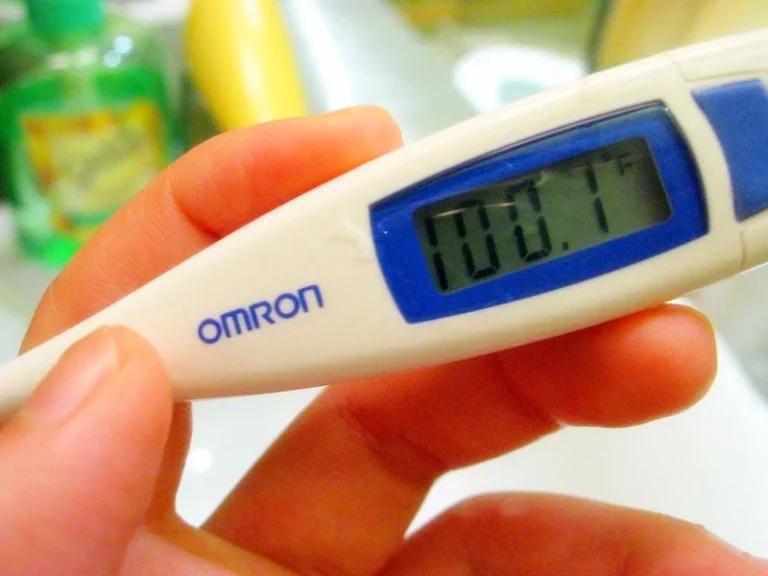Fevers are a common and often concerning problem that affects individuals of all ages. Whether it’s a mild discomfort or a sign of a more serious underlying condition, understanding the nature of fevers is crucial for effective management and prevention. This article will look closely at fevers, exploring the causes, symptoms, and appropriate course of action to address this physiological response.
What is a fever?
A fever is a temporary rise in the body’s core temperature, typically 100.4°F (38°C) or higher when measured orally. This increase in temperature is the body’s natural defence mechanism in response to various stimuli, such as infections, inflammation, or the presence of foreign substances. The hypothalamus, often referred to as the body’s “thermostat,” plays a central role in regulating temperature and initiating the fever response.
Normal body temperature variations
Normal body temperature can vary from person to person and even within the same person throughout the day. The benchmark of 98.6°F (37°C) is not a one-size-fits-all standard, as individual baselines can range from 97°F (36.1°C) to 99°F (37.2°C). Age, time of day, and method of measurement can all influence the observed body temperature.
Defining a fever
While a temperature of 100.4°F (38°C) or higher is considered a fever, the precise definition can vary depending on the individual’s age and the specific circumstances. Infants and young children may be considered to have a fever at a lower threshold, often around 100°F (37.8°C) or higher. Speak to a healthcare professional to determine the appropriate fever criteria for your particular situation.
Causes of fevers
Fevers can be triggered by a wide range of factors, with infections being the most common. Viral, bacterial, and fungal infections can all lead to a body temperature rise as the immune system prepares to fight off the invading pathogens. Additionally, certain medications, vaccinations, and underlying medical conditions can also contribute to the development of a fever.
Viral infections
Viral infections, such as the flu, common cold, and COVID-19, are among the most common causes of fevers. These viral agents can disrupt the body’s temperature regulation, leading to a fever as the immune system responds to the infection.
Bacterial infections
Bacterial infections, including urinary tract infections, pneumonia, and meningitis, can also trigger a fever as the body works to eliminate the harmful bacteria. These types of infections often require medical intervention and sometimes antibiotic treatment.
Inflammatory conditions
Certain inflammatory conditions, such as rheumatoid arthritis, can cause fevers as a result of the body’s immune response to the underlying inflammation. In these cases, the fever may be a symptom of the broader inflammatory process.
Medications and vaccinations
Some medications, including antibiotics, antidepressants, and blood pressure-lowering drugs, can cause fever as a side effect. In addition, certain vaccinations, such as the diphtheria, tetanus, and acellular pertussis (DTaP) vaccine, can sometimes induce a temporary high temperature in response to the introduced antigens.
Other causes
In rare cases, fevers may be associated with more serious health conditions, such as certain types of cancer, heat exhaustion, or even some neurological disorders. It’s crucial to seek medical attention if a fever persists or is accompanied by concerning symptoms.
Fever symptoms
Common symptoms associated with fevers include:
- Chills and shivering
- Sweating
- Headaches
- Muscle aches
- Tiredness and lethargy
- Loss of appetite
- Irritability or changes in behaviour
In infants and young children, additional symptoms may include:
- Earache or pulling at the ears
- Crying or fussiness
- Decreased fluid intake
- Decreased urination
- Pale or flushed skin
The severity and duration of these symptoms can vary depending on the underlying cause of the fever.
Measuring body temperature
Accurately measuring body temperature is crucial for identifying and monitoring a fever. There are several methods available, each with its own advantages and considerations.
Oral temperature
Measuring the temperature orally, using a digital thermometer placed under the tongue, is a common and relatively accurate method for older children and adults. This approach provides a reliable reading of the core body temperature.
Rectal temperature
For infants and young children, a rectal temperature measurement is often considered the most accurate method, as it reflects the true core body temperature. However, this approach requires caution and should be performed by a healthcare professional or with proper guidance.
Ear (tympanic) temperature
Ear or tympanic thermometers measure the temperature of the eardrum, which can provide a close approximation of the core body temperature. These devices are convenient and suitable for older children and adults.
Axillary (armpit) temperature
Measuring the temperature in the armpit, known as the axillary temperature, is a less accurate method but can be suitable for infants and young children. This approach typically underestimates the core body temperature.
Forehead (temporal artery) temperature
Forehead or temporal artery thermometers measure the temperature of the skin on the forehead, which can be a useful and non-invasive option, particularly for children. However, these devices may not provide as accurate a reading as oral or rectal measurements.
It’s important to follow the manufacturer’s instructions carefully when using any type of thermometer and to communicate the method used when reporting a temperature to a healthcare provider.
Treatment
The approach to managing a fever depends on the underlying cause, the individual’s age, and the severity of the symptoms. In many cases, a mild fever can be safely managed at home with supportive care and over-the-counter (OTC) medications.
Home care for mild fevers
For low-grade fevers (less than 101°F or 38.3°C) in otherwise healthy individuals, the primary focus should be on ensuring adequate hydration, rest, and comfort. Providing plenty of fluids, such as water, electrolyte-rich beverages, or popsicles, can help prevent dehydration. Light, comfortable clothing and a cool environment can also help alleviate discomfort.
Fever-reducing medications
If the fever is causing significant discomfort or is higher than 101°F (38.3°C), over-the-counter medications like paracetamol/acetaminophen or ibuprofen can be used to help reduce the fever and reduce associated symptoms. Follow the dosage instructions carefully, especially for children, and avoid combining these medications without medical guidance.
Seeking medical attention
In certain circumstances, a fever may warrant prompt medical advice. Infants under 3 months old with any fever, children between 3-6 months old with a fever higher than 102°F (38.9°C), and individuals of any age with a fever above 103°F (39.4°C) should seek immediate medical attention. Additionally, if a fever is accompanied by concerning symptoms, such as severe headache, stiff neck, difficulty breathing, or persistent vomiting, it’s essential to consult a healthcare provider without delay.
Complications
While fevers are generally a normal and beneficial response to infection or illness, in some cases, they can lead to complications or pose risks, particularly in certain populations.
Febrile seizures
Children between the ages of 6 months and 5 years are at an increased risk of experiencing a febrile seizure, a type of seizure triggered by a rapid rise in body temperature. These seizures can be alarming but are usually harmless and do not cause long-term consequences.
Dehydration
Fevers can lead to increased fluid loss through sweating and decreased fluid intake, putting individuals at risk of dehydration. This is especially concerning in infants and young children, who may have a higher risk of dehydration-related complications.
Organ dysfunction
Extremely high fevers, typically above 105.8°F (41°C), can potentially lead to organ dysfunction if left untreated. This is because the elevated body temperature can disrupt the normal functioning of the body’s systems, potentially causing serious complications.
Underlying conditions
Individuals with pre-existing medical conditions, such as heart or lung disorders, may be at a higher risk of complications from a fever, as the increased metabolic demand can strain the already compromised systems.
Prevention
While fevers are often unavoidable, several strategies can help prevent or mitigate their occurrence:
Vaccination
Receiving recommended vaccinations, such as the flu shot and COVID-19 vaccine, can help reduce the risk of contracting viral infections that can lead to fevers.
Handwashing and hygiene
Practicing good hygiene, including frequent handwashing, can help prevent the transmission of infectious agents that can trigger fevers.
Avoiding exposure
Limiting exposure to individuals who are sick, particularly during outbreaks of contagious illnesses, can lower the chances of contracting an infection that may result in a fever.
Prompt treatment
Seeking medical attention and following the treatment plan for any underlying condition or infection can help resolve the fever and prevent potential complications.
Types of fever
In some cases, individuals may experience recurrent or persistent fevers, which can be a sign of a more complex underlying condition.
Recurrent fevers
Recurrent fevers, also known as periodic fever syndromes, are characterised by repeated episodes of fever that come and go over time. These fevers may be associated with specific triggers, such as stress or exposure to certain environmental factors, and are often accompanied by other symptoms like joint pain or rash.
Persistent fevers
Persistent fevers, which last for more than a few days or fail to respond to standard treatment, may indicate a more serious underlying condition, such as an infection, autoimmune disorder, or even cancer. Prolonged fevers require prompt medical evaluation and investigation to identify the underlying cause.
Conclusion
Fevers are a common and often complex response that can provide valuable insights into the body’s health. By understanding the causes, symptoms, and appropriate management strategies, individuals can seek timely medical attention to ensure optimal health.
Sources
- Fever – Symptoms & causes – Mayo Clinic
- Fever Symptoms & Causes: What Is Considered a Fever?
- High temperature (fever) in adults – NHS
- High temperature (fever) in children – NHS
Medical Disclaimer
NowPatient has taken all reasonable steps to ensure that all material is factually accurate, complete, and current. However, the knowledge and experience of a qualified healthcare professional should always be sought after instead of using the information on this page. Before taking any drug, you should always speak to your doctor or another qualified healthcare provider.
The information provided here about medications is subject to change and is not meant to include all uses, precautions, warnings, directions, drug interactions, allergic reactions, or negative effects. The absence of warnings or other information for a particular medication does not imply that the medication or medication combination is appropriate for all patients or for all possible purposes.







